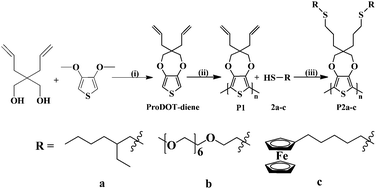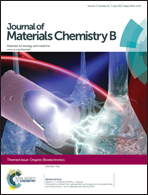Post-polymerization functionalization of poly(3,4-propylenedioxythiophene) (PProDOT) via thiol–ene “click” chemistry†
Abstract
The surface functionalization of conjugated polymers such as the poly(alkoxythiophenes) poly(3,4-ethylenedioxythiophene) (PEDOT) and poly(3,4-propylenedioxythiophene) (PProDOT) provides a potential means for systematically tailoring their physical properties. We previously reported the synthesis of an alkene-functionalized 3,4-propylenedioxy-thiophene (ProDOT) derivative that could be readily modified through thiol–ene “click” chemistry. Here, we investigated the post-polymerization modification of PProDOT surfaces by using a dialkene functionalized variant (ProDOT-diene). The chemical structure of the ProDOT-diene monomer was confirmed by Nuclear Magnetic Resonance (NMR) and Fourier Transform Infrared spectroscopy (FTIR). The ProDOT-diene monomer was either chemically or electrochemically polymerized into the PProDOT-diene polymer, and then subsequently modified with alkyl, PEG, or ferrocene moieties via radical-based thiol–ene chemistry. We found that the normally insoluble PProDOT-diene could be converted into a soluble derivative by grafting alkyl groups onto the polymer chains after chemical polymerization. When electrochemically deposited on indium-tin oxide (ITO) glass electrodes, the conductivity, electroactivity and contact angles of the modified PProDOT-diene films could be tuned over a broad range. Scanning Electron Microscopy (SEM) revealed that post-polymerization modification did not significantly alter the surface morphology of the PProDOT-diene films. Overall, this method allows for efficient, facile tuning of the surface chemistry of poly(alkylthiophene) films, making it possible to tailor properties such as conductivity and wettability for different applications.

- This article is part of the themed collection: Bioelectronics

 Please wait while we load your content...
Please wait while we load your content...